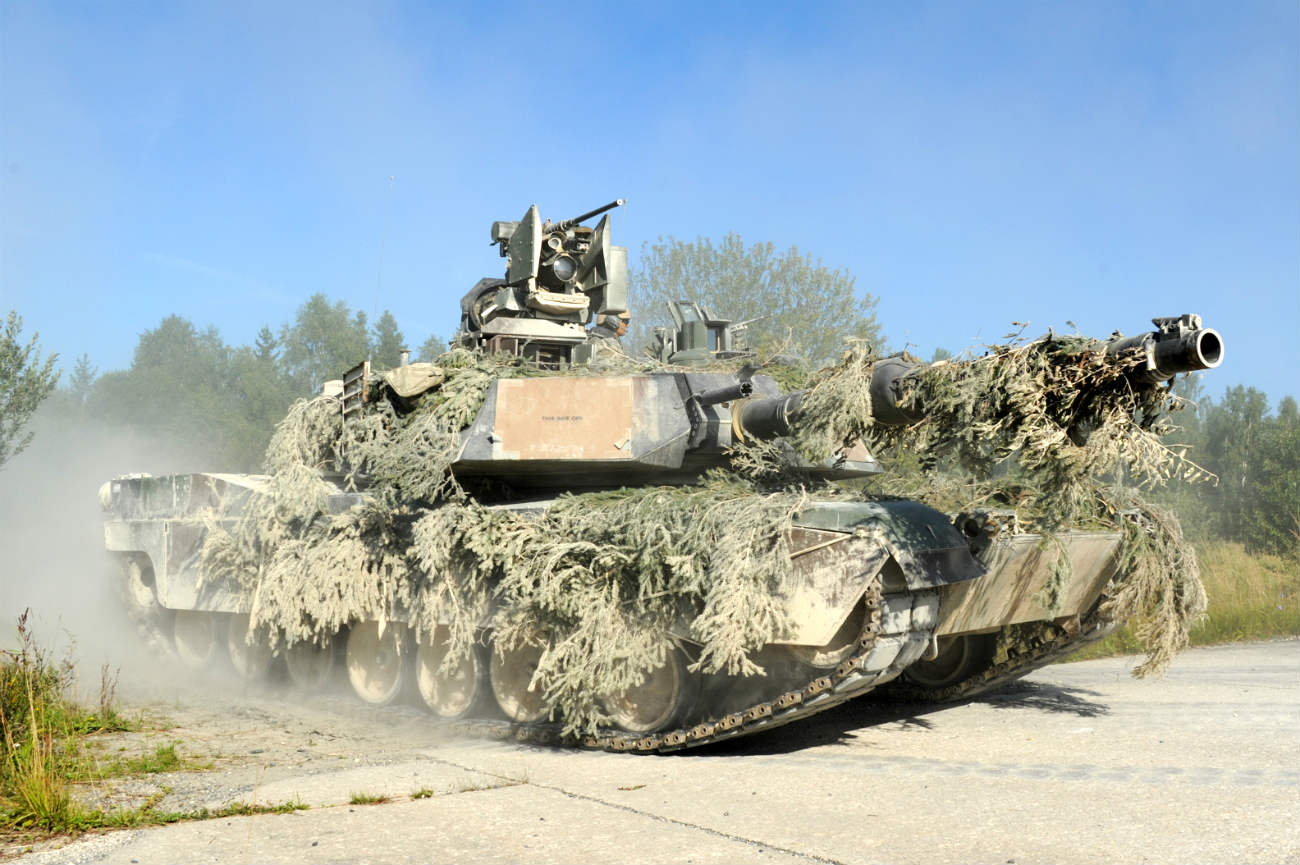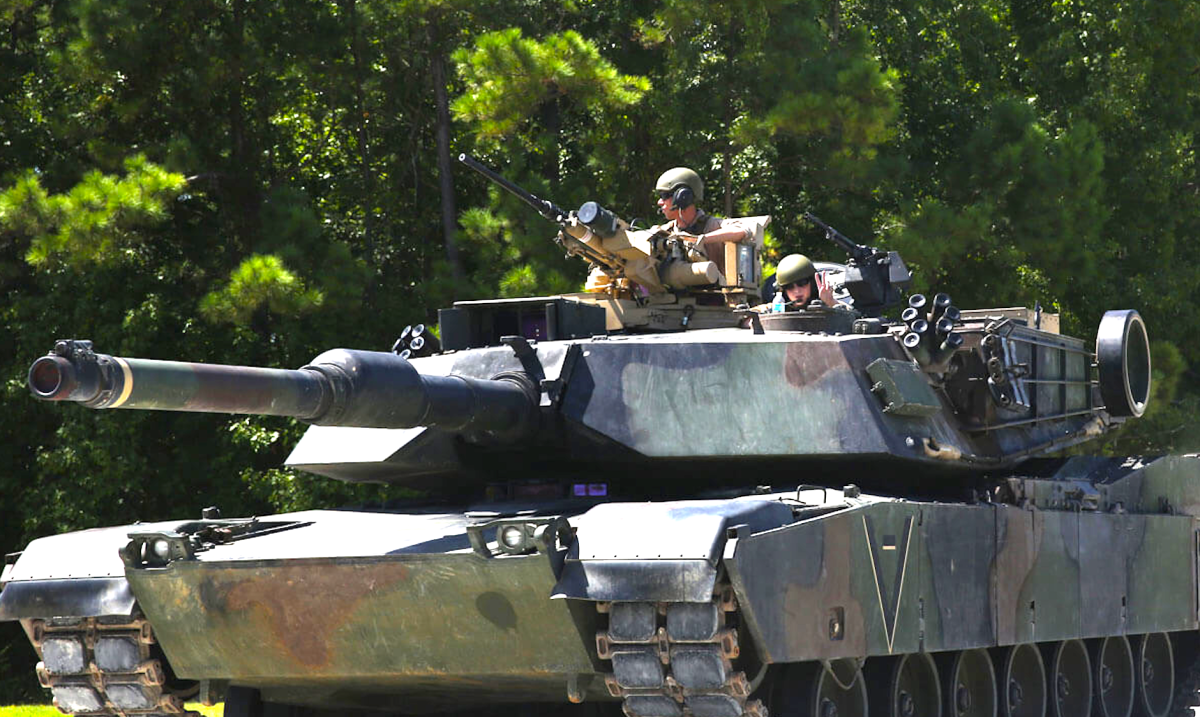M1 Abrams Camouflage - The M1 Abrams is a third generation American main battle tank developed by Chrysler Defse (now Geral Dynamics Land Systems).
And was named after Geral Creighton Abrams. Designed for modern armored ground warfare and now one of the heaviest tanks in service at nearly 68 short tons (almost 62 tons), it introduced a number of modern technologies to the US armed forces, including a turbine engine multi-fuel, sophisticated Chobham compound armor, computer. fire control system, separate storage of ammunition in the blast chamber and NBC protection for the safety of the crew. Initial models of the M1 were armed with a polished 105mm Royal Ordnance L7 cannon, while later variants featured a polished Rheinmetall 120mm L/44.
M1 Abrams Camouflage

The M1 Abrams was developed as a result of the failure of the MBT-70 project to replace the aging M60 tank. The Abrams has three main operational versions, the M1, M1A1 and M1A2, with each new iteration seeing improvements in armament, protection and electronics. The latest version 3 of the hancemt package of the aforementioned M1A2 system or SEPv3 and M1A2 SEPv4 respectively, have undergone extensive improvements, such as improved composite armor, better optics, digital systems and ammunition.
U.s. Army Looking To Speed M1 Abrams Tank Deliveries To Poland
Abrams was supposed to replace the XM1202 Future Combat Combat Systems, but due to its cancellation, the US military decided to continue to maintain and operate the M1 series for the foreseeable future, upgrading it with optics , improved armor and firepower.
The M1 Abrams entered service in 1980 and currently serves as the main battle tank of the United States Army and the former Marine Corps. The export version is used by the armies of Egypt, Kuwait, Saudi Arabia, Australia and Iraq. Abrams were first used in combat in the Persian Gulf War and fought in both the Afghanistan War and the Iraq War in US service, while Iraqi Abrams tanks were involved in the war against the Islamic State and were used by Saudi Arabia during. Jem's Civil War.
During the 1960s, the US Army and the West German Army were collaborating on a common design to replace both the M60 tank and the Leopard 1. The overall goal was to create new unified design with improved firepower to handle new Soviet tanks such as the T-62, while providing better protection against the T-62's new 115 mm smoothbore gun and anti-t -high explosive (HEAT) tank.
The resulting design, the MBT-70, incorporated new technologies throughout. The hydropneumatic suspension provided excellent off-road ride quality and also allowed the driver to raise or lower the tire tank, with the tank at its lowest position only 6 feet (1.8 m) above the -land. The new 1,500 hp class engines used designs that could both reach 43 mph (69 km/h), two new guns were introduced, the US design 152mm with the Shillelagh missile as the weapon key in the long run. The Germans introduced a new 120mm smoothbore design.
M1a2 Abrams Main Battle Tank
Although the design was very capable, its weight increased, as did the budget. By 1969, the cost of the unit was five times the original estimates, causing the Department of Defense to suspend the program.
Tank development continued strictly until January 1970, when the Ministry of Defense concluded its tank partnership with Germany.
Due to problems with the MBT-70, the US Army introduced the XM803, using some of the technology of the MBT-70 but removing some of the more troublesome features. He just managed to create an exclusive system with similar capabilities to the M60.

Congress canceled the XM803 in December 1971, but allowed the Army to allocate $20 million of the remaining funds to develop a new main battle tank.
Super Tank Team M1 Abrams Green&gray Camouflage Showcasts 8882 6.5\
Tank-car and Armaments Command (TACOM) began researching specific targets. After various inputs, it was decided to equip the armor to counter the "high threat" of the T-62's 115 mm gun using planned improvements to the exhaust gas ammunition stabilized with the their armor piercing pens (APFSDS) during the 1980s. and the new 125 mm T-64 and T-72 cannon, which fire high-explosive anti-tank (HEAT) rounds.
On this d appeared a new structural foundation in February 1973. It was supposed to defeat all hits from a Soviet weapon within a radius of 800 meters and 30 degrees to either side. The tank is armed with the M68 105mm gun, a polished version of the Royal Ordnance L7 and a 20mm version of the M242 Bushmaster.
In May 1973, Chrysler Defense and General Motors submitted proposals. Both were armed with a 105mm M68 cannon, a polished L7 and a 20mm Bushmaster. Chrysler chose the 1,500 hp Lycoming AGT1500 gas turbine. The GM model had a 1500 hp diesel similar to the American MBT-70 and XM803 models.
Based on the experiences of the Yom Kippur War this year, several changes were made to the design. "Burlington" armor, newly created in the British Army laboratories, was added to improve protection, especially against HEAT, and the original aim of keeping the weight under 50 short tons (45 tons) was abandoned to include the -the new armor pack. Bushmaster was redundant and deleted. As TACOM continued to refine the detailed design, initial samples of the armor system were taken to the Ballistic Research Laboratory for testing.
M1 Abrams Tank
At that time, Ptagon's procurement system had problems due to the desire to get the best possible design. This often resulted in programs being canceled due to cost overruns, leaving troops with outdated systems, as was the case with the MBT-70. There was a strong movement within the Army to procure a new design within the budget to avoid a repeat of the MBT-70 experience. The Army stated that the new design would cost no more than $507,000 per unit in 1972 (equivalent to $3,280,000 in 2021).
Ptagon's approach to R&D management has been transformed with the XM1. The previous procurement strategy required the government to do a significant portion of the design work. Under the new framework, contractors compete for their own designs, rather than just competing for the right to manufacture a product.
The Ballistic Research Laboratory (BRL) used computer tools during the development of the M1, which led to the development of BRL-CAD. Here, the Vector Geral 3D Graphics Terminal M1 model is shown.

During the period when the initial prototypes were being built, a debate arose between Germany and the United States about the use of the 105 mm gun. The Army planned to introduce several new types of ammunition for the 105 that greatly improve its performance, particularly the XM-774 using reduced uranium. These rounds give it the performance needed to easily defeat any Soviet tank. There was concern that depleted uranium would not be allowed in Germany, perhaps in peacetime, so an upgrade to the M735 tungsten core was also considered.
M1 Abrams Tank Stockvectorkunst En Meer Beelden Van Opslagtank
During the same period, continuous efforts were made to improve NATO logistics by standardizing ammunition as much as possible. The Germans went ahead with their 120mm gun on the Leopard 2K and noted that the British had also deployed their 120mm gun in accordance with their long range combat doctrine.
By 1977, the decision was made to finally upgrade the new tank to a 120 mm gun. After trials between the Royal Ordnance L11A5 and the Rheinmetall Rh-120, the latter was decided. The design of the turrets of both prototypes was modified to allow the mounting of both guns. Although the L11/M256 120 mm gun was selected as the primary weapon for the M1 Abrams in 1979, the weapon's advanced ammunition had not yet been fully developed, delaying its release until 1984.
For two reasons. First, it was due to the large number of M60 tanks with the M68E1 gun, which were still widely distributed in the United States in the eighties, and a large supply of 105 mm ammunition. Fitting the M1 with the M68A1 gun was considered an economic and practical solution that allowed the harmonization of ammunition between the two types of tanks.
Prototypes were supplied by Chrysler and GM in 1976, armed with the 105mm Royal Ordnance L7 lice-built version of the M68E1. They tested each other at the Aberdeen Proving Ground with a Leopard 2 AV prototype for comparison. The Leopard 2 was found to meet US requirements, but was thought to be more expensive.
Poland Agrees Deal To Buy 116 Used Abrams Tanks From Us
Testing showed that GM's design was generally superior to Chrysler's, offering better armor protection and a better fire control and turret stabilization system.
These early pre-production prototypes were temporarily armed with the 105mm M68E1 main gun while the preferred 120mm gun and its ammunition were in the component design and development phase. These prototypes used a combined mount that allowed both 105 mm and 120 mm guns to be evaluated.
During testing, the PSU of both designs showed problems. Chrysler's gas turbine engine had extensive heat recovery systems to improve its fuel efficiency to match that of a traditional internal combustion engine. It didn't turn out that way: the genius used much more fuel than expected, burning 3.8 gallons per mile. New used GM design

M1 abrams tank toy, lego m1 abrams, m1 abrams tank model, m1 abrams rc tank, lego m1 abrams tank, m1 abrams model, m1 abrams, tank m1 abrams, m1 a1 abrams tank, m1 abrams diecast, m1 abrams model kit, m1 abrams for sale
0 Comments